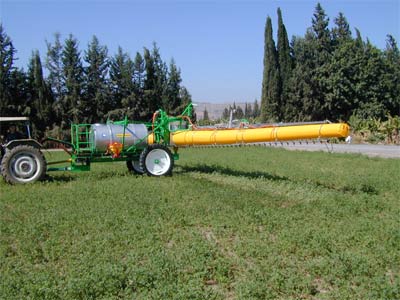In order to make the most efficient use of the herbicide when processing plants, it is necessary to select the height of the rod correctly. The optimum height should be considered such that spraying torches, leaving the nozzles, intersect at half the distance to the treated surface.
The quality of the treatment will be greatly affected by the movement of the sprayer - it is no use to carry out the treatment in case of strong wind or at a speed of more than 20 km/h, since in both cases the losses from wind drift and evaporation are too great. With the rapid movement of the sprayer in the field, it «organizes» the wind itself behind the rods and the tank with the working fluid.
Warm air flows from the heated soil and prevents drops getting on the soil. Evaporation complicates droplets falling on the soil and plants too. For more information see the article «What is better - to reduce the concentration of the solution or the rate of outflow?».
The desire of some farmers to raise the boom «away from the ground» can be understood - with its vertical oscillations, it is possible that it will collide with the soil and damage individual sprayers. But such an attempt to «optimize costs» may lead to a decrease in the quality of the treatment of the territory, which would entail even greater costs due to crop failure and the waste of the herbicide.
So it is better to pay once for a high-quality system of stabilization of the sprayer boom than to constantly overpay for overspending and inefficient use of crop protection equipment.
The optimal boom height depends on the spraying angle of the mounted spray nozzles. And it is better to choose from the possible values 10 cm lower than the above. Every 10 cm of lift increases the losses from the wind and evaporation twice. If the spray angle is 120°, then it is possible to work at a height of 40-60 cm, at an angle of 80°, the allowable heights are 60-90 cm. See below for details on the types of spray nozzles.
Determination of the possible height of the boom when the distance between the nozzles 50cm.
Flat spray nozzles
Hollow cone: TR/ITR 80° - 35-50-70.
Full cone: FC 120° - 35-50-70.
Stream: FL 160° - 100.
What is the best height of the bar seems to be understandable - determined by the type of spray nozzle. But one more question remains unresolved - what is considered a point of reference. If a herbicide must be introduced and the weed height is less than 10 cm, then the height should be counted from the soil level. If the height of the weed exceeds 10 cm, then you need to focus on the average height of its shoots.
If the processing term is late and the spikelets blocked the weeds, the choice of nozzles will be limited to models that provide to droplets ability of «breaking through» the stalks - this is ID/IDK at the lowest possible speed (so that there is no drift forward from the movement of the equipment itself).
When working on a flag sheet or spike, it is necessary to count 40 cm exactly from their level (when processed with fungicides or insecticides).
As it is already becoming clear, it is important that the sprayer boom keeps the constant level above the ground, for which various systems are used today. If the scope of delivery includes ultrasonic height sensors, you should not «save» on this «overkill», since the possible losses over large areas of treatment will be much higher. On the Internet, you can, if you wish, find various «competitions for sprayers», where the developers demonstrate the capabilities of their particular system of maintaining height and protection from collision with the soil.

Instead of changing the height of the bar above the ground, some manufacturers offer a different approach - the air hose. This type of technique has a specific appearance. In this case, water droplets after exiting the sprayer receive additional acceleration to the ground due to the flow of air that is supplied through the air tube. But this is not a «panacea» - such a solution is very well suited for heavily leafy crops or with increased wind.
The minus of the sprayer with an air sleeve are - raised dust when working on dry soil, which degrades the quality of processing, the increase in the price of equipment and the complexity of maintenance. Increases fuel consumption for the operation of the air pump. The sleeve is constantly under pressure and therefore wears heavily. The system itself further complicates the maintenance of the sprayer. Another point is the turbulence of air masses near the ground, which can lead to the ingress of the active substance on the lower surface of the leaves and burns.
As already written in the article, if you need to work in windy weather, then you can set ID high-pressure spray nozzles and work at a pressure of 5-7 atm. In this case, the speed of movement of the droplets is the maximum possible, which reduces the costs of lateral drift from the wind and evaporation.